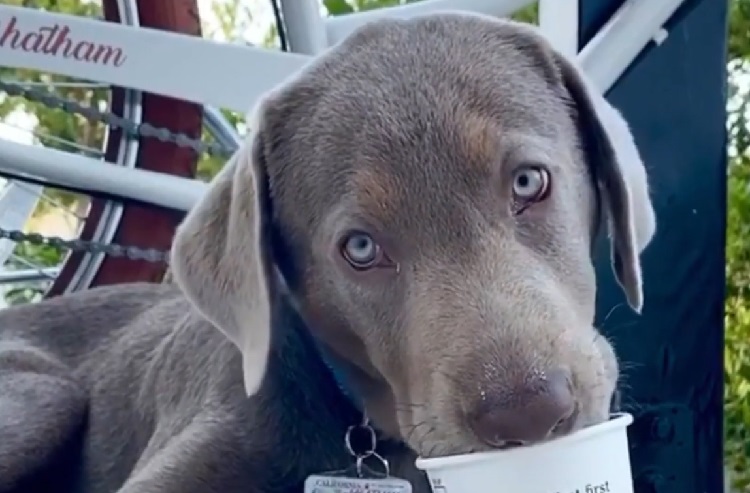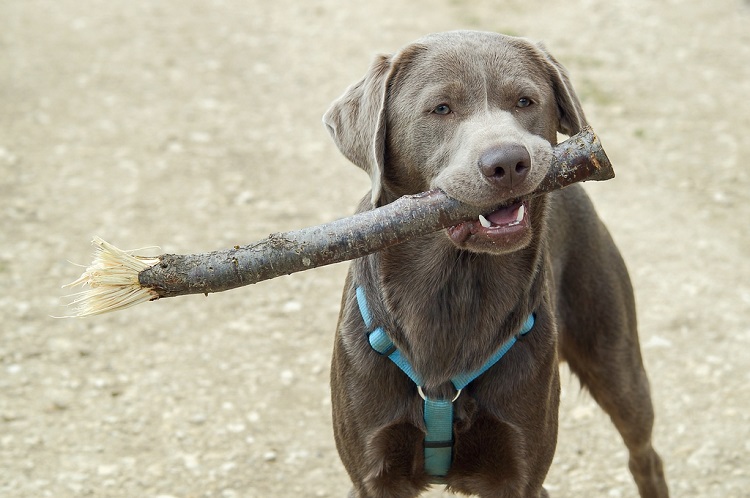The silver Labrador, a striking variation of the beloved Labrador Retriever, captivates with its stunning coat and classic Labrador temperament. Known for their intelligence, eagerness to please, and playful nature, they excel as family companions. This guide delves into the unique aspects of the silver Lab, exploring their temperament, outlining effective training strategies, and highlighting key traits that distinguish them. Whether you’re a seasoned Lab owner or considering welcoming a silver Lab into your home, uncover the essential information you need to provide a happy and fulfilling life for these remarkable dogs.
Labrador Retriever is a quite famous breed, topping the list of great family dogs due to their friendly and social personality. Now, what colors come to your mind when you think of the Labradors? Black, yellow, and chocolate. The Silver color didn’t come to your mind, right?
Silver Labrador Retriever is a beautiful color variation of traditional Labradors; because of the presence of a dilute gene. Their distinct coat color has caught the attention of many; however, not without some controversy. Silver Labradors aren’t considered purebred labradors by some but are adored widely.
So, whether you’re thinking about getting a Silver Labrador yourself, or we spiked your interest in this distinct-looking Labrador, continue reading this article till the end to find out how they are any different from other Labradors and everything you need to know about this breed.
About the Breed
Silver Labrador Retrievers are one of the rarest shades of labradors. They are a hyperactive breed with a compelling sporting nature. They respond well to training, enjoy exploring nature with you, love playing water sports, and are fond of the fetch game, making them perfect for active families.
These beautiful dogs are well-known for befriending every creature they see without any degree of communication. They love being the center of attention and thrive on social interaction.
A little clingy at times, but they deserve all that for their service (just existing). Their agreeable personality and intelligence make them one of the most charming breeds.
Besides their coat color, Silver Labradors aren’t much different from other labs. However, according to the breed standard set by Labrador Retriever Club, true labradors are yellow, black, and chocolate in color. This Silver Labrador is not considered purebred/true labrador color and is not accepted by most kennel clubs.
Many breeders believe that the other colors are due to cross-breeding Labradors with Weimaraners.
Silver Labrador dogs aren’t formally recognized by the American Kennel Club either. According to the AKC, these dogs are basically Cholocate Labradors with a pair of dilute genes, thus recognized as Chocolate Labs.
Pure Chocolate labrador, Yellow labs, and Black Labs from reputable breeders cost around $500-$100, while a Silver Lab puppy sells for $800-$1500.
History of the Silver Labrador
The history of Labrador Retrievers traces back to the 1800s. They were created in Newfoundland and were first introduced by the European to Britain settlers via the ships trading between Canada and Poole.
Labs were initially bred for duck retrieving, assisting in fishing adventures, and as a hunting dog. But with time, their popularity grew more as household pets, and to this date, especially in the western world.
The Silver Lab, however, isn’t as old as the other retrievers. Their history isn’t as chronicled as the other retrievers, either.
They first started appearing, according to some sources, in 1917, while others believe it was in the 1950s. They weren’t considered purebred Labradors by the Kennel Club and other Labrador breeders and were thought to be a mixed breed between Chocolate lab and Weizemarnier.
Now, it is clear that their distinct coat colors are due to the presence of the recessive dilute gene pair that has recently appeared in the Labrador gene pool. The source of that dilute gene is what makes their exact origin vague. This is why the profile of Silver Labs remains controversial for the most part.
Silver Labrador Facts
- Silver Labradors have blue eyes as puppies.
- They are more prone to developing skin problems such as Color Dilution Alopecia than other Labradors.
- They are outgoing and social.
- They are intelligent and highly trainable
Silver Labrador Appearance
Just look at Silver Labrador slaying in this picture, like he was born to model. Silver Labs undoubtedly possess the most distinct silverish gray color that leaves an impact on the observer.
Their eyes are a beautiful shade of yellow, on which a relatively small black pupil looks striking. They have long floppy ears that rest flat on the sides.
Their nose, which is always in search of something to eat ( or sniffing butts), tends to be brown in color. These rare gray labradors have this indescribable charm that keeps winning people over.
Owners tend to be drawn to their wide skulls and muscular build. Their strong(try getting hit by their tail, you will know) tail wags non-stop upon your sight, indicating you’re welcomed and loved!
Now, let’s talk about some concrete physical attributes of a Silver Labrador:
- SizeLabrador Retriever is a large-sized breed. The average height range for almost all grown Silver Labs is between 23.5 and 24.5 inches.
- WeightThe male Silver Lab tends to have a slightly bulkier build in contrast to the female Lab. On average, the weight of a fully-grown Silver Labrador falls between 55 to 80 pounds. The weight range is 45 to 70 pounds in the case of female Labs.
- CoatSilver Lab has a double coat to protect them against harsh cold weather. Theirinner coatis denser and thicker as compared to their outer coat, which is thinand short.Moreover, Silver Lab’s inner coat is water-resistant, meaning they can enjoy water sports for a long time without any impact on their health. Their coat is overall smooth and shiny and feels euphoric to pet.
- ColorThe other color variations Labrador Retrievers can be found in are Black, Chocolate, and Yellow. Yellow and black are the most common coat shades in Labrador Retrievers, and silver and chocolate are the least common.
Silver Lab Puppies
A Silver Labrador puppy is one of the most aesthetically pleasing sights to the eyes in the world. The sparkly blue eyes and the smoky grey shade make a striking contrast.
However, their eyes don’t stay blue. As time progresses, they tend to darken. Their eyes turn yellow after the Silver pups cross the age of 6 to 8 months.
Silver Labrador Temperament and Personality
Talking about Silver Lab temperament, just like other Labrador Retrievers, they too have friendly, affectionate, caring personalities. They are a very intelligent breed that makes the best companion to their human family.
This high-spirited breed matures physically but remains child-like at heart, lifting the mood around the house by being jolly, goofy, jumpy, and adored by absolutely everyone.
The Silver Labrador retriever has an easy-going personality, which means they enjoy every activity with you. They just want to feel your touch, no matter what you do. It is because of their attachment to their owners, which is why they are prone to exhibiting signs of separation anxiety when left alone on their own for too long.
Moreover, it is a social breed that thrives on attention and being around people. These sweet creatures are the best friends of kids. Silver Labs are patient and gentle toward children; they can be their playmates for hours without getting tired. One of the best qualities of These dogs is they get along really well with other dogs and pets.
Silver labs aren’t aggressive toward strangers at all. On the contrary, they get excited at the sight of another human, hang out with them and try to impress them with how cool they are(they actually are).
Plus, they aren’t much of a barking breed either, except when there are a little anxious. They also tend to chewupon objects due to anxiety.
The Silver Lab is an active breed, just like the black and yellow labs. In order to keep them away from destructive behaviors, they need to stay stimulated mentally and physically.
They can be a little prone to nipping, so they do require a lot of your attention. Plus, if you enjoy outdoor adventures like hiking, then Silver Lab will prove to be an extraordinary companion to you.
Silver Labrador Health and Care
Labrador Retrievers’ needs can be a little overwhelming for lazy owners. But in reality, they aren’t that of a high-maintenance breed. Due to being double-coated, they shed a fair amount of hair, especially the Silver Labrador, because of skin problems.
Grooming Requirements
Brushing
As we mentioned above, labs shed quite a bit. And by this, we mean you will be able to collect an adequate amount of hair from all over the house, especially during peak season. That’s why most owners brush their labradors daily to reduce shedding.
Using coconut oil at least once a month can keep their coat neat, shiny, and soft. Gently massage the oil for about five minutes and then clean it with a towel.
Bathing
Bathing your Labrador Retriever once a month is adequate. Brush them before bathing and after bathing, and dry them properly once you’re done bathing them. Use lukewarm water and mild shampoo; it will keep their skin maintained.
Most Labrador Retrievers don’t give you a hard time with bathing, so you can wash them on your own pretty easily.
Nail Trimming
Trim your Silver labs’ nails every two months. However, if you start noticing scratching of nails against the floor while running, walking, or jumping around, trim their nails immediately.
Ear Cleaning
Their adorable floppy ears need to be checked and cleaned frequently to prevent any potential infection. Always include ear cleaning in their grooming session.
Health Complications in Silver Labrador
Every breed is likely to face minor or major health complications. And we have listed all the possible health conditions your Labrador Breed could suffer from. When getting a Silver Labrador, always look for a reputable breeder.
Life Expectancy
Silver Labrador dogs typically have a lifespan between 10 to 14 years. It can vary from dog to dog based on health issues, environment, and other factors.
Color Dilution Alopecia ( CDA)
CDA is a genetically inherited condition common in color-diluted variations of dogs, like the Silver Lab itself. It occurs due to the presence of a recessive gene. In this condition, your dog suffers from skin problems, including hair loss or thinning in the form of patches, itchiness, scaliness, or flaky skin.
Hair thinning/ breakage happens due to the self-destruction of the hair follicles, which tend not to grow back in most cases. It makes your dog’s coat look unflattering but doesn’t impact your dog’s overall health much, except for slight discomfort.
There’s no proper cure for CDA. Vets give treatments to tackle secondary skin infections. They also advise using mild grooming products/shampoos that are gentle on your dog’s skin and aid in decreasing follicular plugging. Avoid using brushes with harsh bristles.
Hereditary Myopathy
As the name explains, hereditary Myopathy, also referred to as ‘ centronuclear myopathy,’ is a genetic disorder that causes muscular frailty. The deficiency of type II muscle fibers causes muscle weakness, resulting in symptoms like stunted growth, trouble swallowing, stiff arched back, shrunken muscles, and low tolerance to exercise.
The signs of hereditary Myopathy start appearing in a six to eight weeks old puppy but aren’t as chronic. They progressively get worse and are the most prominent in 5 months old puppy.
Sadly, most puppies with CNM are subjected to euthanization due to their inability to function normally in life. No dog owner should ever have to go through this painful experience.
Hip and Elbow Dysplasia
In the elbow and hip dysplasia, the ball and socket joints don’t rotate, flex, extend, and move as they should normally, affecting the mobility in dogs. This developmental issue in both joints causes difficulty or friction in climbing stairs, jumping, running, and even walking.
It is a painful condition that drastically affects the quality of your dog’s life and requires you to put in extra care as a dog owner.
Exercise Induced Collapse
Labradors and their unending love for playing and exercise is not something hidden; their energy drive is high. EIC refers to the recessive autosomal inherited trait. Your Labrador Retriever, despite feeling weak, will still try to be active.
It will show signs like dragging/forcing their back legs to move, shaky legs, excessive panting or drooling, and a body temperature higher than usual. Then after five to ten minutes, they collapse.
Extreme exercise sessions are to be avoided in dogs with this condition. However, it’s important to keep your Silver Labradors active, just don’t go overboard with the requirement, as it can lead to weakness and EIC.
Ear Infections
Silver Labradors are the derivatives of Chocolate Labradors. Chocolate Labradors are more susceptible to ear infections than yellow Lab and black ones; about 23 % of them are prone to having them.
Bacteria buildup, yeast, foreign parasites & objects, and allergies can lead to ear infections in dogs. This results in excessive discharge from ears, inflammation, itching, foul odor, and head shaking.
Otitis Externais one of the most common ear infections in Silver Labradors, characterized by ear canal inflammation.
Ear infections are unpleasant and painful and cause discomfort for your dogs. Consult a local veterinarian right away if you notice any of the above symptoms.
Over Eating
Labrador Retrievers are quite popular for being foodies. Some scientists associate it with a genetic mutation. Now, overeating alone isn’t that big of an issue, but the secondary health problems it causes are obesity, diabetes, and reoccurring stomach problems.
Sometimes, overeating might also indicate an underlying serious health issue like hypothyroidism.
Silver Labrador Diet and Nutrition
Your high-energy Labrador Retriever needs a high-quality, nutritious, and protein-rich diet to function healthily. The amount of dog food you feed them may vary a little with their size and weight. For example, your Silver Lab of 50 pounds will need about 2 and a half cups of good quality dog food daily.
The calorie requirement for an 80-pound Silver Labrador is a little higher; they will need about 3 and a half cups of dog food to fulfill their 1,629 calorie requirement each day. Consider getting dog food that has adequate calcium for better joint development.
And remember, it is always best to divide the meals into 3 to 4 intervals for better digestion. These greedy creatures tend to unleash their inner ever-hungry beast at the sight of food, which causes bloating.
Silver Labrador Exercise Requirements
The Silver Lab belongs to an active family. In order to keep them physically and mentally stimulated, 60 minutes of exercise every day is essential. And if your Lab is super active, make it 1.5 hours.
Labs love playing fetch, running, going on fast-paced walking, and being goofy. Thus, their exercise session can include any activity; just make sure they get enough exercise every day!
Dedicate one hour of your time daily to your dog, and give them all your attention and love. Apart from playing and exercising, you can keep them busy by getting them interactive and stimulating toys. Those toys also help them in providing comfort when you leave them alone for a while.
Silver Labrador Training
Silver Labrador’s trainability makes them one of the most popular dog breed in terms of family pets. They are a highly intelligent breed and can be easily trained. They tend to please their owners; that’s why even a good boy phrase works wonders. They are a welcome addition to most families.
Positive reinforcements work well with them; their love for food makes it easier to lure them into doing literally anything you want. All you need is a favorite treat, toy, or any complimentary food, and boom, your Lab becomes the most obedient boy in the world.
In navigating through the exciting journey of training a Silver Labrador, embracing technology can enhance the experience and efficacy of the training process. Delve into innovative approaches by exploring the Halo collar reviews and SpotOn Fence reviews, revealing the potent capabilities of these advanced gadgets in reinforcing training commands and ensuring the safety and restricted mobility of your energetic Lab.
Like kids, it’s effective to start teaching them good manners or tricks from a young age. As puppies, they are easier to control and manage, while the adult Labs are larger in size and can be a little stubborn. Overall, it’s really easy to train your Labrador Retriever.
Conclusion
Altogether, Silver Labrador dogs have all lovable characteristics, just like the traditional Labrador. They are outgoing, energetic, sweet, intelligent, and loyal furry friends. Their friendliness towards kids, strangers and other pets makes them great dogs for families.
You might face a little difficulty finding reputable silver labrador breeders when getting a Silver Labrador. Not to mention the frowns you’ll get from the self-proclaimed lab enthusiasts about Silver Labs ruining the Labrador Retriever breed.
But don’t let these things sway your passion for Silver Labs. Follow your heart and go for it!
Related Guide:
- Australian Shepherd
- White German Shepherd
- Irish Water Spaniel
Silver Labradors, while debated in terms of breed purity, possess the same lovable temperament as their yellow and black counterparts. Intelligent, eager to please, and inherently social, they thrive on activity and human interaction. Training is generally straightforward, utilizing positive reinforcement techniques. Their playful nature and occasional mischievousness underscore the importance of consistent training and socialization, especially during puppyhood. Ultimately, a Silver Labrador, given the right environment and nurturing, makes for a devoted and energetic companion.














